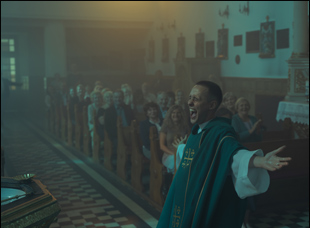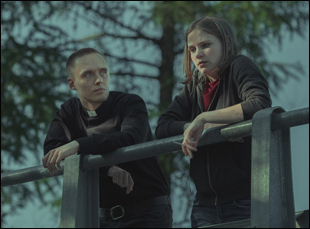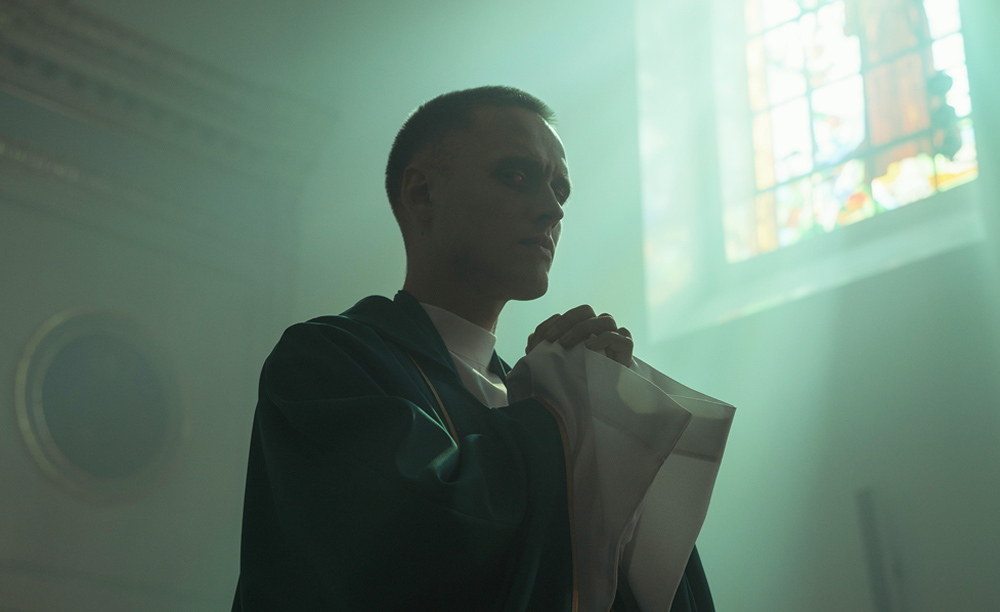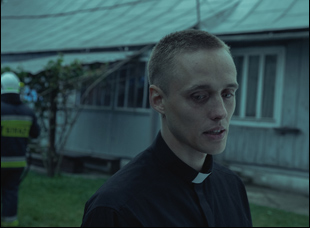As many in the small town where “Corpus Christi” is set await to have their prayers answered, their new priest (Bartosz Bielenia) needs not look any further than his phone. With one person after another filing in to a booth for sacrament, he reads up the first result he sees on Google for “A Guide to Confession,” a fitting parallel to the larger story told in Jan Komasa’s arresting drama in which the solutions may not come from the Lord above, but people having to look within themselves for guidance when their faith can’t explain what’s happened to them.
The place is looking for a miracle when Father Tomasz shows up, having been turned upside down by a car accident that leaves the families of both the person responsible and the friends and family of those who have died to reside uneasily next to each other. As a newcomer to the community, Father Tomasz carries no such baggage, but has plenty of his own when in fact he’s not a priest at all, but rather a recent parolee from a juvenile detention center named Daniel, who is mistaken for a traveling preacher when he leaves his work assignment at a local sawmill and is found sitting on a church pew. While Daniel likely committed a few ungodly acts in his youth, he was taken under the wing of the prison reverend while serving time and would’ve joined the seminary if not for his criminal record, able to recall a few things here and there that enable him to pass himself off as a man of faith. Although Daniel fears being found out after being thrust into a leadership position when the town’s vicar starts showing his age, he uses the seemingly borrowed time to expose the community’s deep divide and attempts to heal with unorthodox methodology that comes naturally to him as an outsider to both the town and the religion.
Built around a riveting performance from Bielenia, “Corpus Christi” navigates territory that may thorny for those onscreen with great elegance, deeply in tune with a central character who finds success sneaking new ideas into a classical structure. Working from a timeless script from Mateusz Pacewicz, Komasa applies expressive 21st century techniques to the film, from stark, moody lighting to a score that pairs traditional strings with more exotic electronica to feed into Daniel/Father Tomasz’s feeling that he’s living between two worlds and not belonging entirely to either one, that make it feel transcendent while supplying the satisfaction of an unfussy, old-fashioned drama. After collecting one prize after another since its premiere at the Venice Film Festival earlier this fall and becoming Poland’s official selection for Best International Feature at the Oscars, the film arrives this week in Los Angeles at AFI Fest and while in town, Komasa and Bielena shared how they came to collaborate on the film, why Bielena’s imperfect audition made him the right fit for the role, and the difficulty of locating a church in Poland to shoot the film.
Jan Komasa: Mateusz Pacewicz, the screenwriter of “Corpus Christi,” became fascinated with the cases of people pretending to be priests in Poland, [and there are] several cases each year like this, so he started to research it when he was 18 years old. He wrote an article on it when he was 22 or 23 and he was approached by a producer Krzysztof Rak, who wanted to buy the rights for the story. Mateusz [insisted], “No, I’m going to try and write it myself,” so he wrote the script and sent it to a few directors and I was one of them. I liked the setting and the absurdity of it, but I had a lot of comments, so I sent an e-mail back and they went silent for two months. Then they sent another version of the script, which had my comments implemented, and I saw the film, my film, and not only did I see the film, but I wanted to shake hands with the guy who did it. That’s how I got finally to meet Mateusz, and we’ve already made another film together called “The Hater,” which is waiting for its premiere in a few months, so it came in a very irregular way for me. I wasn’t pursuing it, but I consider myself very lucky.
Bartosz Bielenia: I [took] an absolutely normal casting way. [laughs] There is a role to take and I’m like, “Okay, let’s try it.” I’ve heard Jan Komasa is doing it, and I knew of this topic, so it was very interesting. But I knew nothing about the script because it was secret. [For the casting] I had a few scenes to do and I did them as good as I could, but I learned [later] from Jan that I wasn’t good – and that was the reason that he took me! [laughs] I wasn’t good enough to be a sinner or I wasn’t good enough to be a preacher…
Jan Komasa: Well, I have to have a few words of explanation. It’s true, but it’s to Bartosz’s credit, because we had 200-something people come in for the audition and they had two scenes to perform. The goal [of one] was to improvise a scene in which you conduct a sermon and the other was to express yourself to the camera in the very angry way as a thug, so [it was seeing] a sinner and a saint. A lot of these guys were perfect at one of the two, but Bartosz was the only one who was like not getting into either 100 percent, which means a lot of space for this ambiguity. He wasn’t a crook, he wasn’t a saint – he was something else. And I loved it. He doesn’t have an established personality, but at the same time, there’s a huge potential.
Bartosz Bielenia: I’m unstable. [laughs]
Jan Komasa: And he looked the same as he does today, [with] long hair and very skinny and intellectual – I showed Bartosz’s picture to my producers and they went nuts, like “Come on, he doesn’t look like the thug from the juvenile detention…” but I’m like, “No, but he has a hunger. I can feel it.” My father is an actor, so I can feel the real hunger in an actor. He wants to play something and he can go to great lengths in obtaining the personality for the film, and he can dress to play a different person.
Bartosz Bielenia: That’s very unusual in Poland, to be honest, for someone to take on someone to prepare for a role in such a degree as we did because for most of the cases, they just hire an actor who looks like he fits. And Jan gave me this opportunity to create the character based on this story.

Bartosz Bielenia: It does change the approach, because for a leading role, you lose a little bit of your freedom. I love to do small roles in films because no one pays attention to what you’re doing. [laughs] And you can go wild. But [with a lead] there’s a lot of expectations that you’re going to do this that way or the director that he has a vision of you that he wants you to perform. But it was a case with Jan where we’re creating someone who is specific for this world that they create with Piotr Sobocinski, the [director of photography], so I felt this freedom that we could create it all the time on the set. Here we had this opportunity to double up this character all the time in every frame and remembering what’s going on with him in his mind and heart and being in it all the time, that helped a lot.
Jan Komasa: At the same time, [we were] watching the [Bartosz] becoming somebody else, [we were watching] as somebody else was becoming somebody else because not only does Bart portray Daniel, but Daniel has to portray himself Father Tomasz, so suddenly you had three different people in one and they all worked together. You have three sermons in the film – the first is the copy-paste of Father Tomasz, but then during the first sermon, Daniel finds his own voice, so the second sermon is more like hip-hop [where it’s improvised] and the third one, the “I Am a Murderer” [sermon], you can see not only Daniel is [fully] developed, but also the person he portrays is also developing into a young priest, not a fake priest anymore. Suddenly, you have a few layers being developed at the same time, which is super fascinating and it took a lot of work to connect the dots. We were updating daily like, “Where are we? What type of scenes are we shooting tomorrow? What should we be aware of before walking onto set?” not to lose any nuance.
Because the sermons are in the same location, did you actually spend a day doing them and getting that build?
Bartosz Bielenia: We did a whole week of sermons. [laughs]
Jan Komasa: Yeah, we wanted to do it in the village where we were shooting, but you have to remember, it’s the bible belt of Poland, the Southern part which is pretty hilly, and unfortunately for us, the church officials from the region didn’t allow us to shoot inside of the church. We couldn’t even trespass the gates, so always with our camera, we were close to the gates and had a character pretend to open it up or close it. The film was at times at odds with the local policy, but it’s a vast swath of land, so we were allowed to shoot anywhere in the range of 200 kilometers and we had to push the church scenes, which was like five days of shooting in church interiors [to the end] to look for a church that will allow us to get in. We had to move with the whole crew to another part of Poland [because] this film was for officials in church controversial. They claimed before in an official document that it’s an anti-Catholic, anti-Christian film, which belittles the role of the priests in the community by showing a regular person can conduct sermons and marriages. During filming, we were still looking for a church. We weren’t 100% sure where it’s going to be.

Bartosz Bielenia: The work with Piotr Sobocinski, the [director of photography] was simply amazing. The three of us were working on all the time on what’s going on with the [character], and Piotr’s eyes were watching so tenderly with so many emotions. He had the idea for this film because when he’s in juvie, it’s dark, but when he’s going out and he’s trying to become a priest, the light comes up. Piotr developed the entire film in terms of light. For example, [when my character] is tending to a dying lady, we needed to shoot this scene in a different way because we had such long [shoot] that it was brightening up during the scene.
Jan Komasa: It was changing the cold to warm during the scene.
Bartosz Bielenia: It was like sunrise.
Jan Komasa: And once you set [the camera in this situation], you can’t reverse it. So I usually work in a different way, like I just put the camera here and I fix the frame and it makes [the cast and crew] get mad at me, but I’m like “action,” and they go [where] the light [is] and then I say, “Okay, okay, keep this emotion. Let’s start over [in a different area].” And they start over and we have six to 10-minute shots. With this particular scene, I couldn’t do it because the lamp was already in a different tone, so [Bartosz] had to be very set, but it was Piotr’s idea that as the lady dies, the more warmth we have in the frame.
Bartosz Bielenia: Yeah, Piotr had huge part creatively, like [saying] “This scene is working” or “We need to try to shoot it differently” or telling me like how he feels about my character doing or saying [something]. He’s very precise and very tender, so it was very good working with him.
What’s it been like traveling with it?
Bartosz Bielenia: It’s amazing. It’s such a pleasure that the film resonates with audience around the world.
Jan Komasa: Yeah, you have a lot of people from different cultures recognizing Bartosz as an emerging talent and mesmerizing personality to watch in the future hopefully, but also the religious theme has resonated with people from different religions, [such as] the Muslim community – in Egypt, the film won Silver Star in El Gouna, a huge festival, so it’s great to see. We’re happy.
“Corpus Christi” will screen at AFI Fest in Los Angeles at the TCL Chinese on November 20th at 6:45 pm and November 21st at 2:45 pm. It will be released next year in the U.S. by Film Movement.





